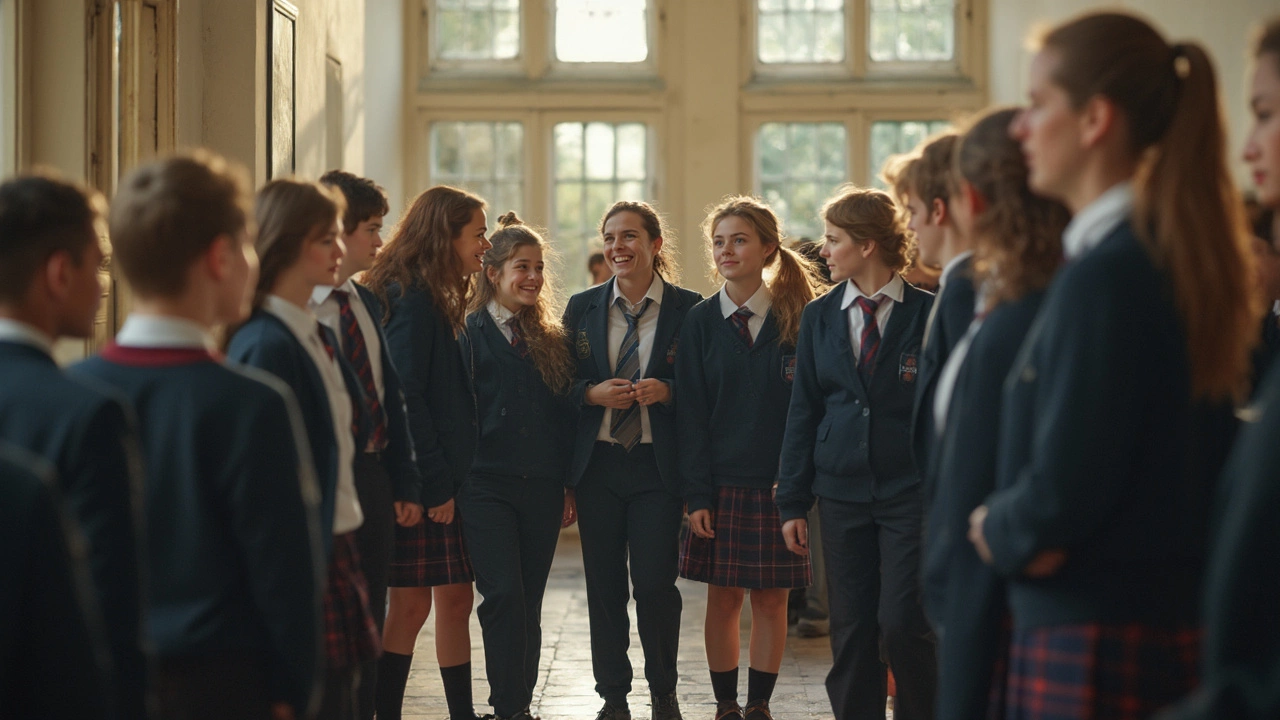Do Uniforms Improve Behavior? Breaking Down the Facts and Real-World Impact

- Cleo Fairchild
- 27 April 2025
- 0 Comments
Ever wondered if those matching shirts and pants really make a difference to how students act? Some people swear that uniforms tame chaos and bring order, but how true is that once you look past the sales pitch?
A study in Nevada followed middle schools that switched to uniforms a few years ago. At first, teachers hoped uniforms would cut down fights and distractions. But it turned out the drop in bad behavior was tiny, and most students felt about the same in the classroom—uniforms didn’t turn troublemakers into angels overnight.
The interesting bit? When schools make uniforms part of a bigger plan—like better teacher support and clearer rules—behavior usually improves more than when schools just swap out street clothes for polos.
If you’re a parent or student just trying to stay out of trouble, knowing how your school’s uniform rules work can really help. Stick around; there’s more to this than just what you wear to school.
- Uniforms and Discipline: What the Studies Show
- Inside the School Walls: Teachers and Students Speak
- Dress Codes vs. Uniforms: What’s the Real Difference?
- Smart Ways to Handle Uniform Policies
Uniforms and Discipline: What the Studies Show
Ask a principal why their school brought in school uniforms, and you’ll usually hear one thing: discipline. But do uniforms really make kids behave better, or is it just wishful thinking?
Researchers have actually tried to measure this. For example, one study out of Houston public schools looked at discipline records before and after uniforms arrived. They saw a small dip in fights and suspensions that first year, but the real drop came from new behavior programs—not the uniforms alone. The difference wasn’t huge and faded after kids got used to wearing uniforms.
Another solid study by the University of Nevada found that students in uniform said they didn’t feel much safer or more respectful. If anything, most teens claimed uniforms just made everyone look the same—they didn’t magically fix bullying or skip days. Teachers were split; some liked the order, but many admitted it didn’t suddenly stop trouble.
If you like numbers, check out this quick stats table from a few real-life uniform studies:
| Location | Suspension Rate Change | Absence Rate Change |
|---|---|---|
| Houston, TX | -3% (with other programs) | No clear change |
| Long Beach, CA | -5% in first year | -1% (not long-term) |
So, the main takeaway: student behavior might improve just a little at first, but uniforms on their own don’t turn things around. Pair them with clear rules and supportive teachers, though, and you may see bigger changes. People hoping for a fix-all are usually disappointed if nothing else at school changes.
Inside the School Walls: Teachers and Students Speak
So what do the people actually wearing and enforcing these school uniforms think? It’s a mixed bag. Some teachers claim that uniforms make their jobs easier, but others say the real challenge—handling discipline—doesn’t just vanish with matching clothes. Ms. Ortega, a math teacher in Dallas, said, “It’s nice not arguing about ripped jeans, but uniforms don’t change how respectful kids are.”
On the flip side, students have plenty to say, too. Some kids feel relaxed because no one can judge their outfits. Others complain uniforms feel strict or boring. One ninth-grader from New Jersey put it like this: “It’s less stress getting ready, but I hate not wearing my favorite sneakers.” A real kicker—students sometimes rebel by bending the rules (like swapping uniform shoes for bright socks) just to “show a little personality.”
If you're wondering about any real effects in the classroom, check this out: a poll by the National Association of Elementary School Principals found that 86% of school leaders said uniforms make a slight difference in reducing teasing and bullying. But, only 47% thought it actually helped with overall student behavior or made kids more focused.
| Who | What They Noted About Uniforms |
|---|---|
| Teachers | Less arguing about clothes, but behavior issues still need work |
| Students | Less pressure about outfits, but some want more freedom |
| Principals | Most say uniforms help stop clothing-based bullying |
The bottom line? Uniforms change some conversations in school, but the bigger discipline and focus problems usually stick around. People working in schools say real progress comes from adults paying attention and students feeling like they matter—not just dressing everyone the same.

Dress Codes vs. Uniforms: What’s the Real Difference?
People often mix up school uniforms with dress codes, but they work in completely different ways. A dress code is more like a set of basic ground rules, saying what students can’t wear (like hats, tank tops, or ripped jeans). Uniforms, on the other hand, make everyone wear the same shirts, pants, or even socks, leaving no room for picking outfits at all.
One big difference? Dress codes are usually up for debate. They change from school to school, or even year to year, depending on what’s getting attention. Uniform policies are way stricter. Everyone shops from the same short list of sweatshirts or blouses, so there’s less guessing whether something is or isn’t allowed.
There’s this idea that dress codes give students some freedom to show who they are, within limits. With school uniforms, that self-expression gets dialed way down, so students tend to express themselves in other ways—think haircuts, shoes, or accessories (if allowed). Sometimes this trade-off actually calms things down, since nobody’s worried about who’s wearing what brand.
- Dress codes try to cut out the most distracting or unsafe clothing.
- School uniforms take away most choices, aiming to help everyone focus on class.
- It's usually easier to spot who doesn’t belong on campus when everyone’s in uniform.
Curious how much these policies really pop up in US schools? Here’s a snapshot:
| Policy Type | Public Schools Using It (2023) |
|---|---|
| Strict Dress Codes | 60% |
| Uniform Policies | 21% |
The rules matter for behavior, but setting clear expectations can be just as powerful as handing everyone the same outfit. A school with a clear dress code that teachers actually follow up on can see the same results as a fully uniformed campus. The trick is laying out what’s okay and sticking to it, so there’s no confusion for students or their parents.
Smart Ways to Handle Uniform Policies
Trying to enforce school uniforms without a plan can end up creating more drama than it solves. Schools that handle these policies well listen to everyone—students, teachers, and parents. When people feel like their voices matter, they’re more likely to follow the rules without a fight.
Let’s talk cost. It’s no secret that uniforms can put a dent in your wallet. According to the National Association of Elementary School Principals, about 85% of parents say affordability is their top concern with uniform policies. Smart schools ease the pressure by:
- Setting up used uniform swaps, so families aren’t stuck buying new sets every year.
- Offering vouchers or discounts for families who need extra help.
- Allowing generic brands from regular stores, not just pricier official suppliers.
Another issue is comfort and expression. When students feel stuffed into itchy or awkward uniforms, it’s hard to focus. That’s why schools that let kids help pick uniform styles (or at least vote on options) usually get less pushback. Big districts like Houston ISD let students give feedback before making any major changes, which actually led to fewer complaints later on.
It’s also key to lay out clear, realistic rules. Instead of nitpicking every detail—like sock color or tiny logos—focus on what actually matters for student behavior and safety. Teachers shouldn’t have to turn into the uniform police every morning. Simpler guidelines make life easier for everyone.
Here’s what works best for classroom management and fairness:
- State dress code expectations in everyday language, not legal jargon.
- Explain why rules exist, so students aren’t just following orders blindly.
- Apply discipline evenly. Don’t let some kids off the hook while others get written up for the same thing.
- Review policies yearly and ask for honest feedback—don’t assume what worked last year still does the job now.
Quick look at how a few schools support families with uniforms:
| School/District | Uniform Swap? | Financial Aid? | Student Voice? |
|---|---|---|---|
| Los Angeles USD | Yes | Yes | Yes |
| New York City DOE | Some schools | Yes | Yes |
| Miami-Dade Public Schools | Yes | Yes | No |
So, if your school is thinking about uniforms, the best approach puts people first. Strong school uniform policies work when they’re fair, affordable, and flexible enough to adjust as real-life needs change.


